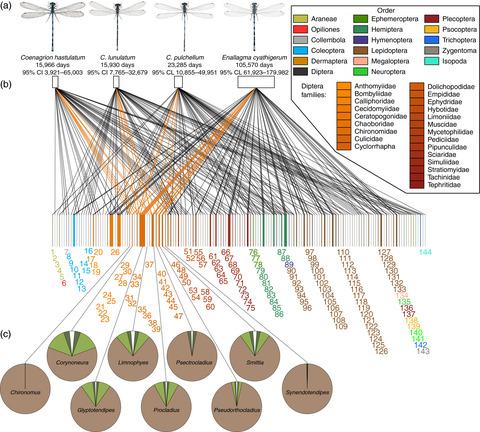当前位置:
X-MOL 学术
›
J. Anim. Ecol.
›
论文详情
Our official English website, www.x-mol.net, welcomes your
feedback! (Note: you will need to create a separate account there.)
Threats from the air: Damselfly predation on diverse prey taxa
Journal of Animal Ecology ( IF 3.5 ) Pub Date : 2020-03-02 , DOI: 10.1111/1365-2656.13184 Kari M Kaunisto 1 , Tomas Roslin 2, 3 , Mark R Forbes 4 , Andre Morrill 4 , Ilari E Sääksjärvi 1 , Anna I E Puisto 1, 3 , Thomas M Lilley 5 , Eero J Vesterinen 1, 2, 3
Journal of Animal Ecology ( IF 3.5 ) Pub Date : 2020-03-02 , DOI: 10.1111/1365-2656.13184 Kari M Kaunisto 1 , Tomas Roslin 2, 3 , Mark R Forbes 4 , Andre Morrill 4 , Ilari E Sääksjärvi 1 , Anna I E Puisto 1, 3 , Thomas M Lilley 5 , Eero J Vesterinen 1, 2, 3
Affiliation

|
To understand the diversity and strength of predation in natural communities, researchers must quantify the total amount of prey species in the diet of predators. Metabarcoding approaches have allowed widespread characterization of predator diets with high taxonomic resolution. To determine the wider impacts of predators, researchers should combine DNA techniques with estimates of population size of predators using mark-release-recapture (MRR) methods, and with accurate metrics of food consumption by individuals. Herein, we estimate the scale of predation exerted by four damselfly species on diverse prey taxa within a well-defined 12-ha study area, resolving the prey species of individual damselflies, to what extent the diets of predatory species overlap, and which fraction of the main prey populations are consumed. We identify the taxonomic composition of diets using DNA metabarcoding and quantify damselfly population sizes by MRR. We also use predator-specific estimates of consumption rates, and independent data on prey emergence rates to estimate the collective predation pressure summed over all prey taxa and specific to their main prey (non-biting midges or chironomids) of the four damselfly species. The four damselfly species collectively consumed a prey mass equivalent to roughly 870 (95% CL 410-1,800) g, over 2 months. Each individual consumed 29%-66% (95% CL 9.4-123) of its body weight during its relatively short life span (2.1-4.7 days; 95% CL 0.74-7.9) in the focal population. This predation pressure was widely distributed across the local invertebrate prey community, including 4 classes, 19 orders and c. 140 genera. Different predator species showed extensive overlap in diets, with an average of 30% of prey shared by at least two predator species. Of the available prey individuals in the widely consumed family Chironomidae, only a relatively small proportion (0.76%; 95% CL 0.35%-1.61%) were consumed. Our synthesis of population sizes, per-capita consumption rates and taxonomic distribution of diets identifies damselflies as a comparatively minor predator group of aerial insects. As the next step, we should add estimates of predation by larger odonate species, and experimental removal of odonates, thereby establishing the full impact of odonate predation on prey communities.
中文翻译:

来自空中的威胁:豆娘对不同猎物类群的捕食
为了了解自然群落中捕食的多样性和强度,研究人员必须量化捕食者饮食中猎物的总量。元条形码方法允许以高分类分辨率对捕食者饮食进行广泛表征。为了确定捕食者的更广泛影响,研究人员应将 DNA 技术与使用标记-释放-重新捕获 (MRR) 方法估计的捕食者种群规模以及个人食物消耗的准确指标相结合。在此,我们估计了四个豆娘物种在一个明确定义的 12 公顷研究区域内对不同猎物类群施加的捕食规模,解决了单个豆娘的猎物物种,捕食性物种的饮食重叠的程度,以及主要猎物种群被消耗。我们使用 DNA 元条形码确定饮食的分类组成,并通过 MRR 量化豆娘种群大小。我们还使用捕食者特定的消耗率估计值,以及关于猎物出现率的独立数据来估计所有猎物分类群的集体捕食压力,以及四种豆娘物种的主要猎物(不咬人的蠓或摇蚊)。四个豆娘物种在 2 个月内总共消耗了相当于大约 870 (95% CL 410-1,800) g 的猎物质量。每个个体在其相对较短的生命周期(2.1-4.7 天;95% CL 0.74-7.9)期间消耗了其体重的 29%-66%(95% CL 9.4-123)。这种捕食压力广泛分布在当地的无脊椎动物猎物群落中,包括4纲、19目和c。140 属。不同的捕食者物种在饮食上表现出广泛的重叠,平均 30% 的猎物由至少两个捕食者物种共享。在广泛食用的摇蚊科中可用的猎物个体中,只有相对较小的比例(0.76%;95% CL 0.35%-1.61%)被食用。我们对种群规模、人均消费率和饮食分类分布的综合表明豆娘是一个相对较小的空中昆虫捕食者群体。下一步,我们应该增加对较大齿科动物捕食的估计,以及实验去除齿科动物,从而确定齿科动物捕食对猎物群落的全面影响。仅消耗了相对较小的比例(0.76%;95% CL 0.35%-1.61%)。我们对种群规模、人均消费率和饮食分类分布的综合表明豆娘是一个相对较小的空中昆虫捕食者群体。下一步,我们应该增加对较大齿科动物捕食的估计,以及实验去除齿科动物,从而确定齿科动物捕食对猎物群落的全面影响。仅消耗了相对较小的比例(0.76%;95% CL 0.35%-1.61%)。我们对种群规模、人均消费率和饮食分类分布的综合表明豆娘是一个相对较小的空中昆虫捕食者群体。下一步,我们应该增加对较大齿科动物捕食的估计,以及实验去除齿科动物,从而确定齿科动物捕食对猎物群落的全面影响。
更新日期:2020-03-02
中文翻译:

来自空中的威胁:豆娘对不同猎物类群的捕食
为了了解自然群落中捕食的多样性和强度,研究人员必须量化捕食者饮食中猎物的总量。元条形码方法允许以高分类分辨率对捕食者饮食进行广泛表征。为了确定捕食者的更广泛影响,研究人员应将 DNA 技术与使用标记-释放-重新捕获 (MRR) 方法估计的捕食者种群规模以及个人食物消耗的准确指标相结合。在此,我们估计了四个豆娘物种在一个明确定义的 12 公顷研究区域内对不同猎物类群施加的捕食规模,解决了单个豆娘的猎物物种,捕食性物种的饮食重叠的程度,以及主要猎物种群被消耗。我们使用 DNA 元条形码确定饮食的分类组成,并通过 MRR 量化豆娘种群大小。我们还使用捕食者特定的消耗率估计值,以及关于猎物出现率的独立数据来估计所有猎物分类群的集体捕食压力,以及四种豆娘物种的主要猎物(不咬人的蠓或摇蚊)。四个豆娘物种在 2 个月内总共消耗了相当于大约 870 (95% CL 410-1,800) g 的猎物质量。每个个体在其相对较短的生命周期(2.1-4.7 天;95% CL 0.74-7.9)期间消耗了其体重的 29%-66%(95% CL 9.4-123)。这种捕食压力广泛分布在当地的无脊椎动物猎物群落中,包括4纲、19目和c。140 属。不同的捕食者物种在饮食上表现出广泛的重叠,平均 30% 的猎物由至少两个捕食者物种共享。在广泛食用的摇蚊科中可用的猎物个体中,只有相对较小的比例(0.76%;95% CL 0.35%-1.61%)被食用。我们对种群规模、人均消费率和饮食分类分布的综合表明豆娘是一个相对较小的空中昆虫捕食者群体。下一步,我们应该增加对较大齿科动物捕食的估计,以及实验去除齿科动物,从而确定齿科动物捕食对猎物群落的全面影响。仅消耗了相对较小的比例(0.76%;95% CL 0.35%-1.61%)。我们对种群规模、人均消费率和饮食分类分布的综合表明豆娘是一个相对较小的空中昆虫捕食者群体。下一步,我们应该增加对较大齿科动物捕食的估计,以及实验去除齿科动物,从而确定齿科动物捕食对猎物群落的全面影响。仅消耗了相对较小的比例(0.76%;95% CL 0.35%-1.61%)。我们对种群规模、人均消费率和饮食分类分布的综合表明豆娘是一个相对较小的空中昆虫捕食者群体。下一步,我们应该增加对较大齿科动物捕食的估计,以及实验去除齿科动物,从而确定齿科动物捕食对猎物群落的全面影响。











































 京公网安备 11010802027423号
京公网安备 11010802027423号